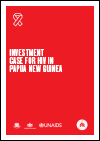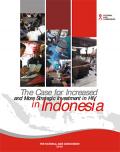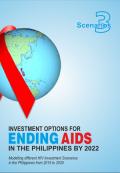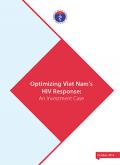Site Search
Displaying results 1 - 10 of 12

Resource | Publications,
This Investment case for HIV in PNG shows that because of the hard work and considerable investments of the Papua New Guinea (PNG) Government, its international partners, church groups, civil society and people living with HIV, the HIV epidemic has been checked with prevalence at a little under 1 percent of the total population. With estimates in 2000 predicting an HIV epidemic at five times that level, it is clear that investments in HIV work but the job is far from complete. The Investment case for HIV in PNG (“the Investment Case”) also shows that we cannot be complacent: among the general population in the National Capital District, HIV prevalence is 1.6 percent and it is above 1 percent throughout the highlands, where the bulk of the population lives. In some key populations, prevalence is much higher: around 15% of sex workers and 9% of men who have sex with men are living with HIV, and new infections are increasing in both groups. PNG also has the highest STI rates in the region.

Resource | Publications,
This report is the outcome of a comparative analysis of seven national investment cases from the region and highlights key findings and recommendations for further action. The findings from this report and the Regional Expert Consultation on Developing Evidence-Based National HIV Investment Cases and Sustainability Plans held in December 2015 are expected to contribute to the knowledge base on how the ESCAP Member States have developed national investment cases (NICs), and identify examples of best practice. The analysis was based primarily on a desk review of the investment cases of Bangladesh, Indonesia, Myanmar, Nepal (Investment Plan), the Philippines, Thailand, and Viet Nam, with additional input from in-country respondents and the Regional Expert Consultation.

Resource | Publications,
Under the leadership of the Government of Bangladesh (GOB), the National AIDS/STD Programme (NASP) and UNAIDS in liaison with civil society stakeholders started the process of the Investment Case for Bangladesh to enhance the mobilization of resources (domestic and external donor) to end AIDS BY 2030 through Fast-Track strategies. The Investment Case makes an effort to outline how to maximize efficient use of resources, based on current evidence, by re-visiting the strategic directions in prevention efforts to fast track and intensify. The process included several review sessions facilitated by the Ministry of Health and Family Welfare, engaging researchers, civil society and government.

Resource | Publications,
This analysis was done to estimate the required investments in the future to respond to HIV and AIDS in a cost-effective and optimal manner.
The result of the Investment Case Analysis (ICA) has been reviewed by all stakeholders involved in the national technical team which comprised the Ministry of Health, the National AIDS Commission, and development partners like DFAT, WHO and UNAIDS. The results of this review are based on an analysis of the best and most current data available as of September 2014 in terms of HIV epidemic data, the 2013 IBBS for category B districts, the 2013 Papua IBBS, and revised 2014 unit cost for treatment. Analysis obtained from the study results has also guided the selection of the optimal scenario for the National HIV and AIDS Strategy and Action Plan 2015-2019 and informed the preparation of Indonesia’s Global Fund New Funding Model Concept note in 2015.

Resource | Publications,
This paper is an offshoot of the 2014 AIDS Epidemic Model (AEM) Report endorsed by the Department of Health in August 2014. The AEM report utilized a set of tools (AEM workbooks) that provided techniques for estimating and measuring the impact of past and future programs on the HIV epidemic in the Philippines (1970-2050).

Resource | Publications,
This paper is an offshoot of the 2014 AIDS Epidemic Model (AEM) Report endorsed by the Department of Health in August 2014. The AEM report utilized a set of tools (AEM workbooks) that provided techniques for estimating and measuring the impact of past and future programs on the HIV epidemic in the Philippines (1970-2050).

Resource | Publications,
This paper is an offshoot of the 2014 AIDS Epidemic Model (AEM) Report endorsed by the Department of Health in August 2014. The AEM report utilized a set of tools (AEM workbooks) that provided techniques for estimating and measuring the impact of past and future programs on the HIV epidemic in the Philippines (1970-2050).

Resource | Publications,
With the recent updates on the HIV epidemic status and the current program responses, the various strategic information, including updated surveillance results from the HSS and community behavioral surveillance (BSS) and integrated behavioral and biomarker surveillance (IBBS) among different key populations, updated intervention program results (HIV care and antiretroviral treatment, prevention of mother to child HIV transmission, etc.), population structural change, etc. The Bureau of Epidemiology, in cooperation with the Thailand and the Thai Working Group on HIV/AIDS Projections (2010), the A2 Thailand, and the Thailand MoPH-U.S. CDC Collaboration operate the Projection for HIV/AIDS in Thailand 2010 -2030 using the recent update version of Asian Epidemic Model, entitled AIDS Epidemic Model (AEM) for HIV projection among adult 15+ years old and the Spectrum for HIV projection among children lesser than 15 years old.

Resource | Publications,
The Investment Case analyses Viet Nam’s HIV epidemic and response, examines the impact and implications of various future scenarios, and establishes priorities that aim to make the response more effective, efficient and sustainable, toward the global goal of Ending AIDS by 2030.

Resource | Publications,
Thailand has committed to the targets of the 2011 High Level Meeting on AIDS and has a prioritized National Strategy which pledges a two-thirds reduction in incidence in sexual transmission, and through injecting drug use, by 2016.
Thailand has the potential to be one of the first countries in Asia to ‘End AIDS’ and reach the first milestone on the road to end AIDS by meeting the 2015 HLM targets. The end of AIDS can become a reality if Thailand is able to effectively utilize the preventive effects of antiretroviral treatment. Thailand as has already shown this is possible through the virtual elimination of HIV infections from mother to child.





